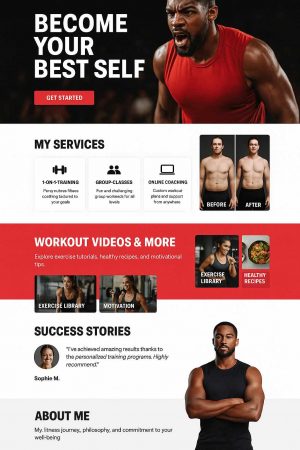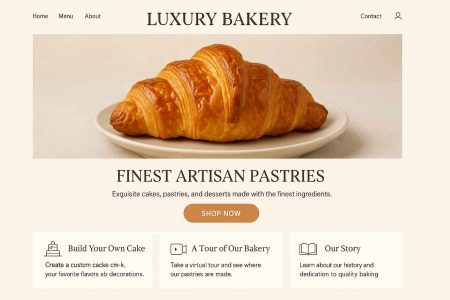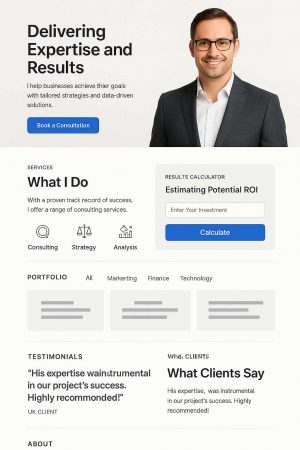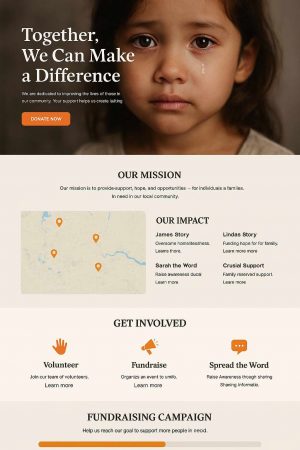
Creative Website Ideas for UK Small Businesses: Design, Trends & Inspiration
For UK small businesses, a website is more than just an online brochure; it’s a crucial marketing tool, a digital storefront, and often the first impression you make. Creative web design can level the playing field, allowing you to compete effectively. But what makes a website truly stand out and contribute to growth?
This guide explores innovative website ideas tailored for UK small businesses. We’ll delve into the importance of good web design, showcase inspiring examples, and offer actionable tips to create a unique, engaging online experience that reflects your brand and resonates with your target audience.
Why is Creative Web Design Crucial for UK Small Businesses?
A distinctive online presence is essential for a business of any size. For businesses who are keen use their website to generate leads, creative web design offers significant advantages:
Differentiation: Helps your business stand out from the crowd.
Brand Storytelling: Effectively communicates your brand’s message, values, and unique selling propositions (USPs) to a UK audience.
Enhanced User Experience (UX): A well-designed, easy-to-navigate site keeps visitors engaged and reduces bounce rates. In one of Neilsen’s case studies on the Return on Investment (ROI) from usability, a website reduced its bounce rate from 30% to a minuscule 2.5% through a simple redesign
Professionalism & Trust: A polished, thoughtfully designed website builds credibility and trust with potential customers. According to the Stanford Web Credibility Research Project, 75% of users make judgments about a company’s credibility based on their website design.
Increased Engagement: Interactive elements and multimedia can increase time spent on site and encourage interaction.
Read more from Forbes about the importance of branding in business.
Understanding Good Web Design Fundamentals
Effective web design is a balance of aesthetics (how it looks) and functionality (how it works). Key principles include:
Simplicity & Clarity: A clean, uncluttered layout that focuses attention on key messages and makes navigation easy. Avoid overwhelming visitors.
User Experience (UX): Designing with the user’s journey in mind. Intuitive navigation, logical flow, and ease of finding information are paramount.
Consistency: Uniform design elements (colours, fonts, button styles, layout) across all pages reinforce brand identity and build familiarity.
Responsiveness (Mobile-First): Ensuring your website looks and functions flawlessly on all devices (desktops, tablets, and especially mobiles). Given high UK mobile usage, a mobile-first design approach is often best. As of 2023, around 60 million individuals in the United Kingdom (UK) were using mobile internet, which translates to around 93 percent of the country’s total population.
Accessibility (WCAG Standards): Designing for inclusivity, so people with disabilities can access and use your website. This also benefits all users and can improve SEO.
Page Load Speed: Sadly a feature often overlooked by web developers, fast-loading pages are crucial for user retention and SEO.
Leveraging Modern Web Design Trends for UK Businesses
Staying current can give your small business website an edge. Consider these trends:
Minimalism & Whitespace: Using negative space effectively to create a clean, focused, and sophisticated look. Improves readability and draws attention to key elements.
Bold Typography: Using distinctive and expressive fonts to make a statement and enhance brand personality.
Dark Mode: Offering an alternative colour scheme that can reduce eye strain and save battery life on some devices.
Microinteractions & Animations: Subtle animations or interactive elements that provide feedback, guide users, or add a touch of delight (use sparingly to avoid slowing down the site).
Multimedia Integration: Using high-quality images, videos, and audio to tell stories, showcase products, and engage users more deeply.
Sustainable/Eco-Friendly Design: Reflecting environmental consciousness through design choices (e.g., efficient code, green hosting mentions), appealing to eco-aware UK consumers. 21% of Britons are willing to invest more in products that favour sustainability.
Creative Website Ideas & Examples for UK Small Businesses
Let’s explore how different types of UK small businesses can use creative web design, and take a look at some (AI generated) pictures of how some of these features might look:
Example 1: The Local UK Bakery – A Visual & Sensory Delight
Idea: Use high-quality, mouth-watering photography of baked goods. Implement a warm, inviting colour palette.
Creative Feature: An interactive “Build Your Own Cake/Hamper” tool, or a virtual tour.
UX Focus: Simple navigation for online ordering, clear menu, easy contact for local delivery/collection.
Brand Storytelling: Share the bakery’s history, passion for local ingredients, or community involvement.
Example 2: The Innovative UK Tech Startup – Interactive & Future-Focused
Idea: Clean, modern, and slightly futuristic aesthetic. Use subtle animations or microinteractions to showcase innovation.
Creative Feature: Interactive product demos or simulations. Animated infographics explaining complex technology simply.
UX Focus: Clear explanations of services/products, prominent case studies or client logos, easy way to request a demo or contact sales.
Brand Storytelling: Focus on problem-solving, vision for the future, team expertise.
Example 3: The Independent UK Fashion Boutique – Stylish Storytelling
Idea: Visually driven with high-quality lookbook-style photography and videos. Reflect the boutique’s unique style.
Creative Feature: “Shop the Look” features, virtual try-on (AR if feasible), style quizzes to offer personalised recommendations.
UX Focus: Easy product filtering (size, colour, style), clear sizing guides (UK sizes), seamless checkout.
Brand Storytelling: The founder’s fashion journey, commitment to sustainable/ethical fashion (if applicable), features on local UK designers.
Example 4: The UK Freelance Consultant – Professional & Credibility-Focused
Idea: Clean, professional, and trustworthy design. Focus on showcasing expertise and results.
Creative Feature: Interactive portfolio with filterable case studies. A “Results Calculator” showing potential ROI for clients.
UX Focus: Clear service descriptions, prominent testimonials from UK clients, easy booking for consultations.
Brand Storytelling: Highlight unique methodology, years of experience, client success stories.
Example 5: The UK Local Charity/Nonprofit – Engaging & Emotion-Driven
Idea: Use impactful imagery and compelling storytelling to connect emotionally with visitors.
Creative Feature: Interactive map showing impact, stories of beneficiaries (with consent), clear progress bars for fundraising goals.
UX Focus: Easy-to-find donation buttons (consider Gift Aid information for UK donors), clear information on how to volunteer or get involved.
Brand Storytelling: Focus on the cause, the impact of donations, stories of hope and change within the UK community.
Example 6: The UK Personal Trainer/Fitness Coach – Motivational & Action-Oriented
Idea: Dynamic, energetic design with inspiring imagery and transformation photos (with consent).
Creative Feature: Interactive workout planners, video library of exercise tutorials, a blog with healthy recipes and motivational tips from a UK perspective.
UX Focus: Clear service packages, easy booking for sessions/classes, testimonials from UK clients.
Brand Storytelling: Coach’s personal fitness journey, philosophy, focus on holistic well-being.


Essential Features for Every Successful UK Small Business Website
Beyond creative flair, these elements are non-negotiable:
Clear Calls-to-Action (CTAs): Prominent buttons/links guiding users to desired actions (e.g., “Shop Now,” “Get a Quote,” “Book a Consultation,” “Sign Up for our UK Newsletter”).
Trust Signals & Social Proof:
Testimonials from UK customers.
Case studies showcasing results.
Logos of clients or partners.
Industry accreditations or memberships (relevant to UK standards).
Secure payment gateway logos (if ecommerce).
Keyword research targeting UK searchers.
Optimised page titles, meta descriptions, headings, and content.
Technical SEO (site speed, mobile-friendliness, sitemap).
Local SEO (if applicable, Google Business Profile optimisation).
Analytics Integration:
Google Analytics 4 (GA4) setup to track visitor behaviour, traffic sources, conversions.
Understanding these metrics is crucial for refining your website and marketing.
Contact Information & Location (if applicable): Easy-to-find UK phone number, email address, physical address (with map for local businesses).
Privacy Policy & Cookie Consent: Essential for GDPR compliance in the UK.
Tips for Translating Ideas into Engaging Web Content
Know Your UK Audience: Understand their needs, language, and cultural references.
Simplify Complex Information: Use clear, concise language. Break down information into digestible chunks (short paragraphs, bullet points).
Tell a Story: Weave your brand narrative into your content to make it more engaging and memorable.
Use High-Quality Visuals: Professional photos, relevant icons, and well-designed graphics enhance understanding and appeal. Optimise images for web.
Craft a Compelling ‘About Us’ Page: Share your mission, values, team (if applicable), and what makes your UK business unique. Make it personable.
Display Products/Services Effectively: Use clear images, concise descriptions highlighting benefits (not just features), and customer reviews.
Aligning Your Website with Your UK Brand & Marketing Goals
Your website is a central pillar of your brand identity.
Cohesive Brand Experience: Ensure your website’s design (colours, fonts, imagery, tone of voice) is consistent with your overall branding across all platforms (social media, print materials relevant to the UK market).
Support Marketing Campaigns:
Create dedicated landing pages for specific UK marketing campaigns.
Ensure campaign messaging and visuals are reflected on your website.
Use CTAs that align with campaign goals.
Turning Web Design Challenges into Growth Opportunities for Your UK Business
Creating an effective website for your UK small business can seem daunting, but it’s a prime opportunity to differentiate your brand, connect with your audience, and drive growth. Embrace creative web design principles, stay informed about modern trends, and focus on providing an excellent user experience.
Embrace Innovation & Continuous Improvement
Digital marketing, particularly in the UK, is always evolving. Regularly review your website’s performance using analytics, gather customer feedback, and be willing to adapt and improve.
Boost Your Business
Ready to transform your UK small business website into a powerful growth engine?
Greyturtle specialises in creative, effective web design and digital marketing solutions.




